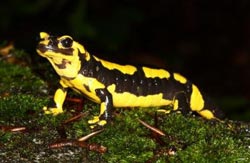Salamanders under threat from deadly skin-eating fungus

This image shows a fire salamander.<br><br>Credit: Frank Pasmans<br>
Fire salamanders, recognisable by their distinctive yellow and black skin patterns, have been found dead in the country's forests since 2010. The population has fallen to around 10 individuals, less than four per cent of its original level, but what has been killing them has been a mystery until now.
Scientists from Ghent University, Imperial College London, Vrije Universiteit Brussel and the Dutch conservation group Ravon have isolated a new species of fungus from the dead animals and found that it can rapidly kill fire salamanders. They have named the fungus Batrachochytrium salamandrivorans, the second part meaning “salamander-eating”, and report their findings today in the Proceedings of the National Academy of Sciences.
Fungi are increasingly recognised as important threats to biodiversity. A species related to the new fungus, Batrachochytrium dendrobatidis (Bd), has plagued amphibian populations across the globe and is thought to have wiped out more than 200 species worldwide. It causes the disease chytridiomycosis, which the International Union for the Conservation of Nature has called the single most devastating infectious disease in vertebrate animals.
The study's lead author, Professor An Martel from the University of Ghent, said: “In several regions, including northern Europe, amphibians appeared to be able to co-exist with Bd. It is therefore extremely worrying that a new fungus has emerged that causes mass mortalities in regions where amphibian populations were previously healthy.”
Co-author Professor Matthew Fisher, from Imperial College London, said: “It is a complete mystery why we are seeing this outbreak now, and one explanation is that the new salamander-killing fungus has invaded the Netherlands from elsewhere in the world. We need to know if this is the case, why it is so virulent, and what its impact on amphibian communities will be on a local and global scale. Our experience with Bd has shown that fungal diseases can spread between amphibian populations across the world very quickly. We need to act urgently to determine what populations are in danger and how best to protect them.”
The fungus can be passed between salamanders by direct contact, and possibly by indirect contact although this hasn't been proven. It invades the animal's skin, eventually destroying it completely. In tests, the fungus was not able to infect midwife toads, which have been threatened by chytridiomycosis, but whether other species might be vulnerable is unknown.
The scientists have brought surviving salamanders into captivity to protect the remaining population in the Netherlands. To aid further studies, they have also developed a diagnostic tool that enables the new fungus to be quickly identified. They tested 100 salamanders from Belgium, where the population has remained healthy, but so far there is no sign that the fungus has spread beyond the Netherlands.
The research was funded by the Royal Zoological Society of Antwerp, the European Research Council and Biodiversa.
For more information or photos of fire salamanders please contact:
Sam Wong
Research Media Officer
Imperial College London
Email: sam.wong@imperial.ac.uk
Tel: +44(0)20 7594 2198
Out of hours duty press officer: +44(0)7803 886 248
Notes to editors
1. A Martel et al. 'Batrachochytrium salamandrivorans sp. nov. causes lethal chytridiomycosis in amphibians.' PNAS 2013.
2. About Imperial College London
Consistently rated amongst the world's best universities, Imperial College London is a science-based institution with a reputation for excellence in teaching and research that attracts 14,000 students and 6,000 staff of the highest international quality. Innovative research at the College explores the interface between science, medicine, engineering and business, delivering practical solutions that improve quality of life and the environment – underpinned by a dynamic enterprise culture.
Since its foundation in 1907, Imperial's contributions to society have included the discovery of penicillin, the development of holography and the foundations of fibre optics. This commitment to the application of research for the benefit of all continues today, with current focuses including interdisciplinary collaborations to improve global health, tackle climate change, develop sustainable sources of energy and address security challenges.
In 2007, Imperial College London and Imperial College Healthcare NHS Trust formed the UK's first Academic Health Science Centre. This unique partnership aims to improve the quality of life of patients and populations by taking new discoveries and translating them into new therapies as quickly as possible.
Media Contact
More Information:
http://www.imperial.ac.ukAll latest news from the category: Ecology, The Environment and Conservation
This complex theme deals primarily with interactions between organisms and the environmental factors that impact them, but to a greater extent between individual inanimate environmental factors.
innovations-report offers informative reports and articles on topics such as climate protection, landscape conservation, ecological systems, wildlife and nature parks and ecosystem efficiency and balance.
Newest articles

Combatting disruptive ‘noise’ in quantum communication
In a significant milestone for quantum communication technology, an experiment has demonstrated how networks can be leveraged to combat disruptive ‘noise’ in quantum communications. The international effort led by researchers…

Stretchable quantum dot display
Intrinsically stretchable quantum dot-based light-emitting diodes achieved record-breaking performance. A team of South Korean scientists led by Professor KIM Dae-Hyeong of the Center for Nanoparticle Research within the Institute for…

Internet can achieve quantum speed with light saved as sound
Researchers at the University of Copenhagen’s Niels Bohr Institute have developed a new way to create quantum memory: A small drum can store data sent with light in its sonic…





















